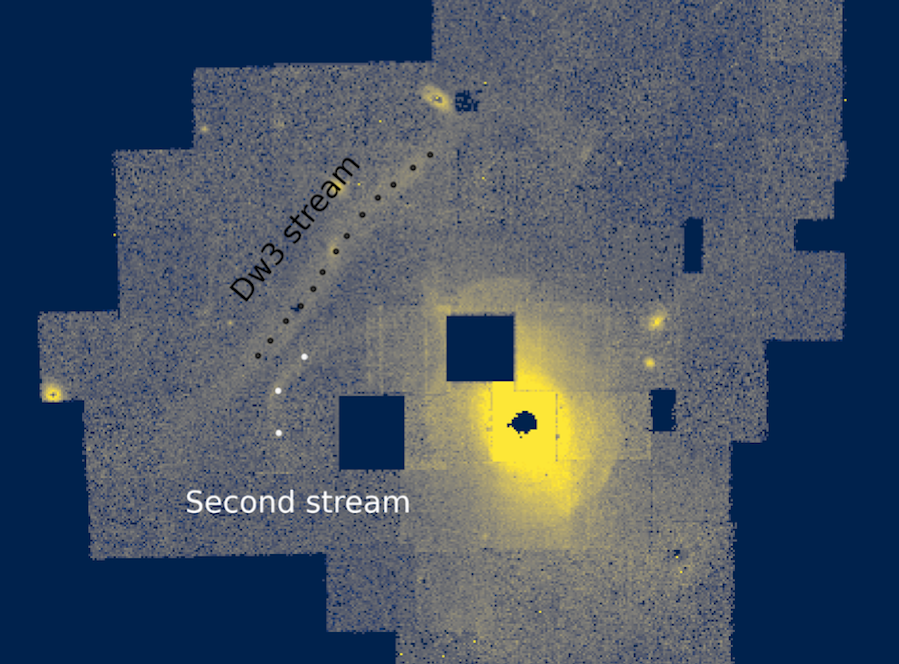Extragalactic streams & dark matter
 We are about to enter an exciting new era, where data of thousands of streams orbiting other galaxies will become available over the course of the next five years facilitated by the European Space Agency’s space-based survey mission, Euclid, the ground-based Vera C. Rubin Observatory (Rubin), and the Nancy Grace Roman Space Telescope (Roman). Pearson recently showed that it is feasible to use extragalactic stellar streams to learn about the dark matter halos of host galaxies (Pearson et al. 2022b). She modeled the Dwarf3 stellar stream in Centaurus A's halo (see image) and used it to set a lower limit on the dark matter mass of the host galaxy. This provides preliminary evidence that dark matter can be mapped in external galaxies with stellar streams. She found that there are many viable stream models that fit the data well, provided that Cen A has a halo mass larger than M200 > 4.70 × 10^12 Msun.
We are about to enter an exciting new era, where data of thousands of streams orbiting other galaxies will become available over the course of the next five years facilitated by the European Space Agency’s space-based survey mission, Euclid, the ground-based Vera C. Rubin Observatory (Rubin), and the Nancy Grace Roman Space Telescope (Roman). Pearson recently showed that it is feasible to use extragalactic stellar streams to learn about the dark matter halos of host galaxies (Pearson et al. 2022b). She modeled the Dwarf3 stellar stream in Centaurus A's halo (see image) and used it to set a lower limit on the dark matter mass of the host galaxy. This provides preliminary evidence that dark matter can be mapped in external galaxies with stellar streams. She found that there are many viable stream models that fit the data well, provided that Cen A has a halo mass larger than M200 > 4.70 × 10^12 Msun.
 Nibauer & Pearson (2025) recently showed that the morphology of extragalactic streams alone can be used to stitch together radial profiles of dark matter halos. The paper introduces the code X-Stream, a new method that uses images of stellar streams, the remnants of disrupted star clusters and galaxies, to map how dark matter is distributed. Using the GPU-powered code streamsculptor (Nibauer et al. 2025a), we generate thousands of simulated streams to compare with real observations and reveal the shape and density of dark matter halos. This approach can test ideas beyond the standard cold dark matter model and explore how galaxies’ merger histories shape their halos. With upcoming missions such as Euclid, the Rubin Observatory, ARRAKIHS, and the Nancy Grace Roman Space Telescope, X-Stream will help create the most detailed dark matter maps yet for thousands of galaxies across the universe. See Pearson's talk discussing this work at a recent DESC LSST Telecon.
Nibauer & Pearson (2025) recently showed that the morphology of extragalactic streams alone can be used to stitch together radial profiles of dark matter halos. The paper introduces the code X-Stream, a new method that uses images of stellar streams, the remnants of disrupted star clusters and galaxies, to map how dark matter is distributed. Using the GPU-powered code streamsculptor (Nibauer et al. 2025a), we generate thousands of simulated streams to compare with real observations and reveal the shape and density of dark matter halos. This approach can test ideas beyond the standard cold dark matter model and explore how galaxies’ merger histories shape their halos. With upcoming missions such as Euclid, the Rubin Observatory, ARRAKIHS, and the Nancy Grace Roman Space Telescope, X-Stream will help create the most detailed dark matter maps yet for thousands of galaxies across the universe. See Pearson's talk discussing this work at a recent DESC LSST Telecon.